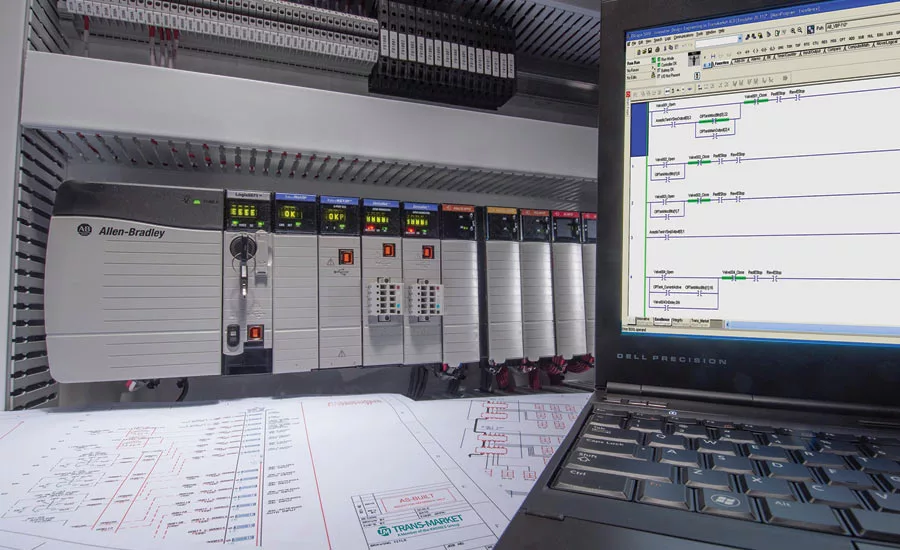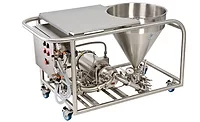Processing automation offers essential data collection
Data analysis diagnoses maintenance needs, improves efficiency

Data collection and analysis are essential to improving automated processing operations, experts say. (Image courtesy of Trans-Market LLC)
From the beginning of the production line to the end, automation has become more prevalent in the beverage industry as it further incorporates technology that helps maximize production capacity, and increase efficiency and accuracy throughout processing operations.
Driving the increased adoption of processing automation are the variety of benefits that the equipment provides to beverage-makers throughout the process, according to experts.
“We’re always working toward providing our customers with efficiency improvements, business intelligence and predictive maintenance,” says Joe Vizzi, automation manager at Tampa, Fla.-based Trans-Market LLC, a member of the Krones Group. “… We provide our customers with a more consistent product by improved repeatability. Our customers also have been pleased with yield improvements from our reporting and data analysis capabilities.”
John Tertin, director of sales and marketing at ESE Inc., Marshfield, Wis., notes that automation within the production process is continuing to advance and proliferate as more processes become automated throughout processing operations. For example, ESE has worked on many paperless systems, which provide accuracy, shareability, availability and efficiency benefits, he says.
“There’s a lot of information and asset parameters and other things that operators are recording that are available within the automation system,” he explains. “Really leveraging that availability and being able to collect that information [is important] so that the human resources that are at a facility are leveraged to their full potential and they’re adding the most benefit that they can to the process, which is different than having them write a lot of information down and spend 10 percent of their valuable time doing things that could be automated, faster [and] more accurate, and having wider availability of that information.”
Going further, Tertin notes that these benefits go hand-in-hand with data collection. As ingredient sourcing and transparency become more important to consumers, automated processing operations with data analysis can be the key to success. In the same respect, data collection also can be essential to making operations more efficient and for troubleshooting. Additionally, data analysis from production automation can help improve a beverage-maker’s responsiveness to market changes and detect issues within the processing automation, he adds.
“The availability of information is certainly critical to [efficiency], [and] being able to safely share that information between systems and the network infrastructure that’s required to do that reliably and again safely, from a security standpoint, is incredibly important,” Tertin says. “… Another [benefit] is on the efficiency front, but more on responsiveness. Especially with beverage producers, their SKUs and their demand from their customers changes so frequently that you need to be a nimble organization. You need to be able to respond to that customer demand quickly, so we’re working with some of our vendors to grow increasing awareness of different [manufacturing execution system] (MES) platforms, so that our customers can directly link their production systems with their [enterprise resource planning] (ERP) systems and product formulation, so that they’re able to be more responsive and nimble when their customers do make changes.”
The implementation of an MES allows the various pieces of equipment in a production line to act as one cohesive unit, as opposed to different machines acting on their own throughout a line, he explains. As a result, problem areas easily can be located for maintenance or continuous improvement purposes, he adds.
“[I]f there’s an issue that’s experienced at any point in the process, you’re virtually guaranteed that there is going to be data around that point of a process that you can review in an at-hock kind of way,” Tertin says.
As automation proliferates and technology advances, new and faster processing platforms and high-speed communication advancements, like wireless and I/O platforms, have become available, Trans-Market’s Vizzi explains.
Likewise, as automation becomes more technologically connected, the amount of relevant data proliferates, Tertin adds.
“The Industrial Internet of Things (IIoT) [has influenced] the availability of information from everything from [variable frequency drives] (VFDs) to flow meters, even the conductivity transmitter now will give you multiple pieces of information, not just conductivity,” he explains. “The incorporation and adaptation of Ethernet down to the process device level has really made a lot more information available to us. Before, we just knew what the speed reference of a VFD was, now we know what the speed reference is, what the temperature is, how many amps it’s drawing, [and] what the safe torque-off and other safety parameters are. You can dig into really very precise secondary parameters from a device, which has been hugely important in being able to incorporate some other technologies.”
Data collection and analysis will continue to be essential to improving automated processing operations, experts say.
“[There will be] more and more data collection with more sophisticated analysis of the data to improve [the] efficiencies of operations,” Vizzi says.
Continued implementation of MES and networks is anticipated as the beverage industry further incorporates the IIoT, ESE’s Tertin says.
“Not just having the information but making it available — not having a brick wall between a control system and ERP system, but having a very carefully crafted screen, so that you can leverage both of those systems together and minimize paperwork and optimize production and efficiency, but doing so carefully, safely and securely,” he says. BI
Looking for a reprint of this article?
From high-res PDFs to custom plaques, order your copy today!





